案例分析,百事可乐
- 格式:pdf
- 大小:1.03 MB
- 文档页数:7
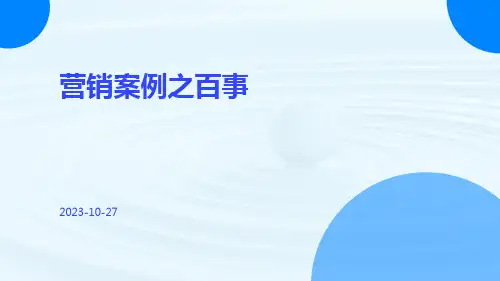
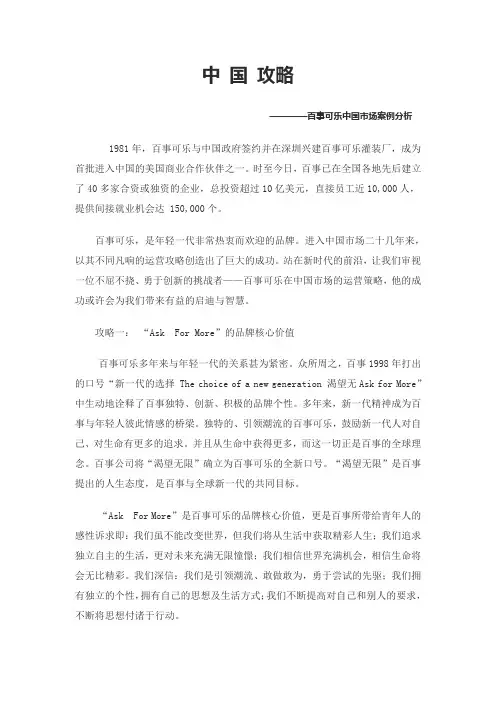
中国攻略————百事可乐中国市场案例分析1981年,百事可乐与中国政府签约并在深圳兴建百事可乐灌装厂,成为首批进入中国的美国商业合作伙伴之一。
时至今日,百事已在全国各地先后建立了40多家合资或独资的企业,总投资超过10亿美元,直接员工近10,000人,提供间接就业机会达 150,000个。
百事可乐,是年轻一代非常热衷而欢迎的品牌。
进入中国市场二十几年来,以其不同凡响的运营攻略创造出了巨大的成功。
站在新时代的前沿,让我们审视一位不屈不挠、勇于创新的挑战者——百事可乐在中国市场的运营策略,他的成功或许会为我们带来有益的启迪与智慧。
攻略一:“Ask For More”的品牌核心价值百事可乐多年来与年轻一代的关系甚为紧密。
众所周之,百事1998年打出的口号“新一代的选择 The choice of a new generation 渴望无Ask for More”中生动地诠释了百事独特、创新、积极的品牌个性。
多年来,新一代精神成为百事与年轻人彼此情感的桥梁。
独特的、引领潮流的百事可乐,鼓励新一代人对自己、对生命有更多的追求。
并且从生命中获得更多,而这一切正是百事的全球理念。
百事公司将“渴望无限”确立为百事可乐的全新口号。
“渴望无限”是百事提出的人生态度,是百事与全球新一代的共同目标。
“Ask For More”是百事可乐的品牌核心价值,更是百事所带给青年人的感性诉求即:我们虽不能改变世界,但我们将从生活中获取精彩人生;我们追求独立自主的生活,更对未来充满无限憧憬;我们相信世界充满机会,相信生命将会无比精彩。
我们深信:我们是引领潮流、敢做敢为,勇于尝试的先驱;我们拥有独立的个性,拥有自己的思想及生活方式;我们不断提高对自己和别人的要求,不断将思想付诸于行动。
在中国,百事品牌与年轻人共同将“Ask For More”的品牌核心价值体现为实实在在的行动,譬如:赞助“八运会”、赞助中国甲A足球联赛、支持中国申奥成功等等。
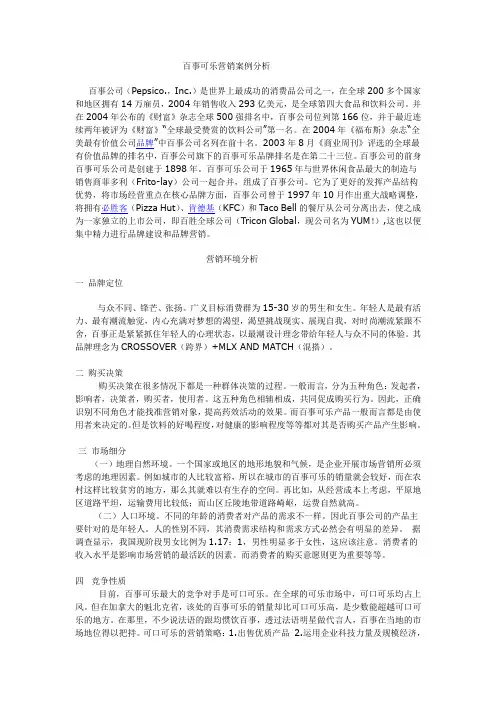
百事可乐营销案例分析百事公司(Pepsico.,Inc.)是世界上最成功的消费品公司之一,在全球200多个国家和地区拥有14万雇员,2004年销售收入293亿美元,是全球第四大食品和饮料公司。
并在2004年公布的《财富》杂志全球500强排名中,百事公司位列第166位,并于最近连续两年被评为《财富》“全球最受赞赏的饮料公司”第一名。
在2004年《福布斯》杂志“全美最有价值公司品牌”中百事公司名列在前十名。
2003年8月《商业周刊》评选的全球最有价值品牌的排名中,百事公司旗下的百事可乐品牌排名是在第二十三位。
百事公司的前身百事可乐公司是创建于1898年。
百事可乐公司于1965年与世界休闲食品最大的制造与销售商菲多利(Frito-lay)公司一起合并,组成了百事公司。
它为了更好的发挥产品结构优势,将市场经营重点在核心品牌方面,百事公司曾于1997年10月作出重大战略调整,将拥有必胜客(Pizza Hut)、肯德基(KFC)和Taco Bell的餐厅从公司分离出去,使之成为一家独立的上市公司,即百胜全球公司(Tricon Global,现公司名为YUM!),这也以便集中精力进行品牌建设和品牌营销。
营销环境分析一品牌定位与众不同、锋芒、张扬。
广义目标消费群为15-30岁的男生和女生。
年轻人是最有活力、最有潮流触觉,内心充满对梦想的渴望,渴望挑战现实、展现自我,对时尚潮流紧跟不舍,百事正是紧紧抓住年轻人的心理状态,以最潮设计理念带给年轻人与众不同的体验。
其品牌理念为CROSSOVER(跨界)+MLX AND MATCH(混搭)。
二购买决策购买决策在很多情况下都是一种群体决策的过程。
一般而言,分为五种角色:发起者,影响者,决策者,购买者,使用者。
这五种角色相辅相成,共同促成购买行为。
因此,正确识别不同角色才能找准营销对象,提高药效活动的效果。
而百事可乐产品一般而言都是由使用者来决定的。
但是饮料的好喝程度,对健康的影响程度等等都对其是否购买产品产生影响。
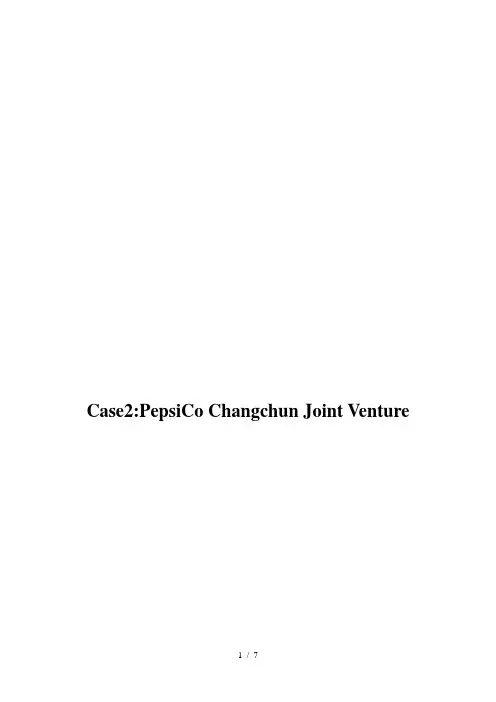
Case2:PepsiCo Changchun Joint VentureCase2:PepsiCo Changchun Joint Venture1. Describe the case briefly.1993年,中国进行一系列改革,股权合资经营作为一种新的企业形式建立起来。
1994年6月,百事可乐东亚地区财务副总裁安德里·哈沃斯基于对中国政治和经济市场前景的预测,收集了关于在中国长春建立股权合资经营公司的资料,其中包括反映百事可乐公司财务状况、营运能力的相关数据表格。
表一和表二提供百事可乐的财务报告——损益表和资产负债表;表三提供百事可乐谅解备忘录城市图。
表四是长春合资经营公司计划的资本支出、折旧和摊销的预测;表五是与其他百事可乐合资公司的比较;表六,列出了远期汇率预测表,主要提供跨国集团的汇率变动对集团内部贸易的影响分析数据;表七,从对合资公司的营业费用和存货的预测,来考虑经营活动对未来现金流量的影响;表八提供的是预计营运资本变化情况;表九是瓶箱净押金的估计。
财务部根据以上表格分析未来12年百事公司的预计净现金流量,想要通过运用资本预算方法--净现值法和内含报酬率法,以此为基础来预测公司未来盈利情况,从而判断投资决策的合理性和可行性。
2. Use the information in the case to construct NPV and IRR analysis on the proposed Changchun bottling joint bottling joint venture. Based on the results, what would be your decision on the proposed Changchun joint venture? (Excel version)见Excel 表二(第二题)其中:一、税率的选择合资公司从盈利的第一年起两年内免税(允许亏损递延),两年后,合资公司将享受三年内减税7.5%,以后将需要交纳15%的全额赋税,而且,一项新的当地税收政策在2001年生效,预测是3%的税率。
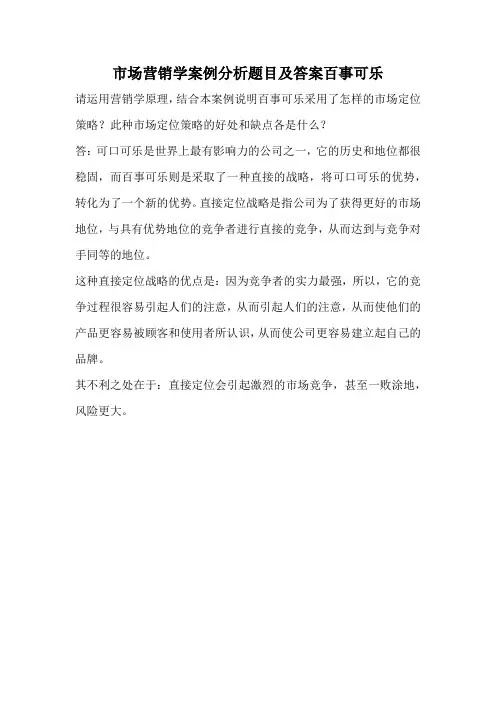
市场营销学案例分析题目及答案百事可乐
请运用营销学原理,结合本案例说明百事可乐采用了怎样的市场定位策略?此种市场定位策略的好处和缺点各是什么?
答:可口可乐是世界上最有影响力的公司之一,它的历史和地位都很稳固,而百事可乐则是采取了一种直接的战略,将可口可乐的优势,转化为了一个新的优势。
直接定位战略是指公司为了获得更好的市场地位,与具有优势地位的竞争者进行直接的竞争,从而达到与竞争对手同等的地位。
这种直接定位战略的优点是:因为竞争者的实力最强,所以,它的竞争过程很容易引起人们的注意,从而引起人们的注意,从而使他们的产品更容易被顾客和使用者所认识,从而使公司更容易建立起自己的品牌。
其不利之处在于:直接定位会引起激烈的市场竞争,甚至一败涂地,风险更大。
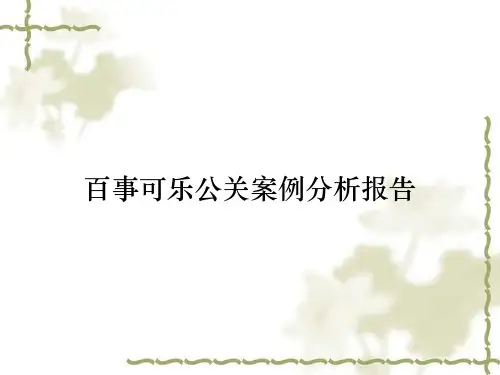
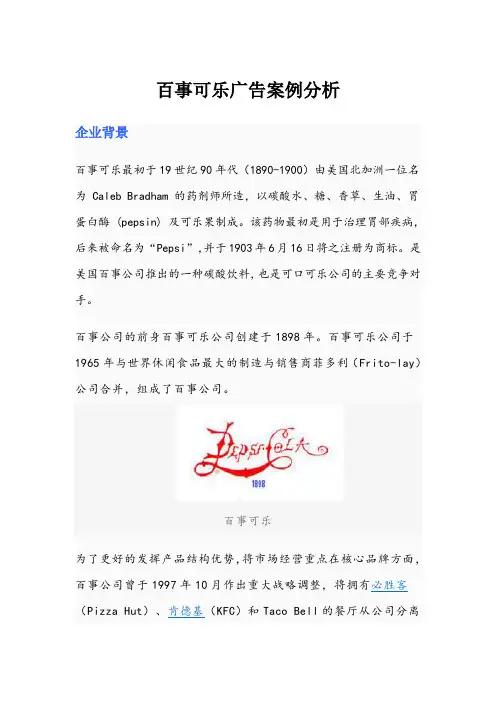
百事可乐广告案例分析企业背景百事可乐最初于19世纪90年代(1890-1900)由美国北加洲一位名为Caleb Bradham 的药剂师所造,以碳酸水、糖、香草、生油、胃蛋白酶(pepsin) 及可乐果制成。
该药物最初是用于治理胃部疾病,后来被命名为“Pepsi”,并于1903年6月16日将之注册为商标。
是美国百事公司推出的一种碳酸饮料,也是可口可乐公司的主要竞争对手。
百事公司的前身百事可乐公司创建于1898年。
百事可乐公司于1965年与世界休闲食品最大的制造与销售商菲多利(Frito-lay)公司合并,组成了百事公司。
百事可乐为了更好的发挥产品结构优势,将市场经营重点在核心品牌方面,百事公司曾于1997年10月作出重大战略调整,将拥有必胜客(Pizza Hut)、肯德基(KFC)和Taco Bell的餐厅从公司分离出去,使之成为一家独立的上市公司,即百胜全球公司(Tricon Global,现公司名为YUM!),这也以便集中精力进行品牌建设和品牌营销。
1999年,百事公司将其百事可乐罐装百事公司(Pepsico.,Inc.)是世界上最成功的消费品公司之一,在全球200多个国家和地区拥有14万雇员,2004年销售收入293亿美元,为全球第四大食品和饮料公司。
广告定位“新一代的选择”是百事可乐的广告语,从这则广告语中我们就能体会到它的市场定位。
广告语1898年清爽、可口,百事可乐1903年提神、爽心、增进消化1905年可口之饮料1906年天然饮料——百事可乐1907年百事可乐:可口、健康1909年百事可乐:使你才气焕发1910年喝百事可乐,让你心满意足1923年这就是健康:百事可乐品尝百事,你将喜欢它1928年百事可乐,激励你的士气1932年一样的价格,双倍的享受1939年一样的价,双倍的量1940年百事可乐是属于你的饮料1943年令人诱惑的口味1945年百事可乐:更多、更好1949年口味最好、花钱更少1950年量多、活力更多1953年清新、爽口1958年爱社交,喝百事喝百事,增友谊1959年百事可乐令你心旷神怡1961年这就是百事,它属于年轻的心1963年奋起吧,你就属于百事新一代1964年让自己充满活力,你是百事新一代1967年口味独一无二,百事可乐向前涌动品尝无可比拟的百事1969年生活/奉献你从生活中获取,百事从奉献中获取1971年拥有一个百事的日子1973年成为百事人,感受自由心1975年百事挑战,让你的感觉来决定1976年拥有百事时代1977年必胜客与百事可乐合并1979年把握百事精神,赋予百事挑战1982年喝百事可乐,享受一生美味啊!百事的时代1983年现在就去体会百事1984年百事可乐,新一代的选择1987年百事可乐:美国的选择1990年亲爱的,这就是您所需要的1992年不能没有它——百事可乐1993年年轻、开心,喝百事1995年百事之外,别无选择1996年改变新的一页:百事可乐1998年新一代的选择The choice of a new generation 渴望无限(Ask for More)1999年百事,渴望无限快乐的可乐2003年百事,这就是可乐2004年突破渴望(Dare for More) 敢于第一(Dare to Be No.1)2007年突破创造发现More2008年全民携手舞动中国2008年欢聚时刻共享百事2009年百事我创2010年LOVE!PEPSI NEX2011年渴望就是力量(出现在谢霆锋成者为王的百事广告曲中)首先是准确定位:从年轻人身上发现市场,把自己定位为新生代的可乐;并且选择合适的品牌代言人,邀请新生代喜欢的超级巨星作为自己的品牌代言人,把品牌人格化形象,通过新一代年轻人的偶像情节开始了文化的改造。
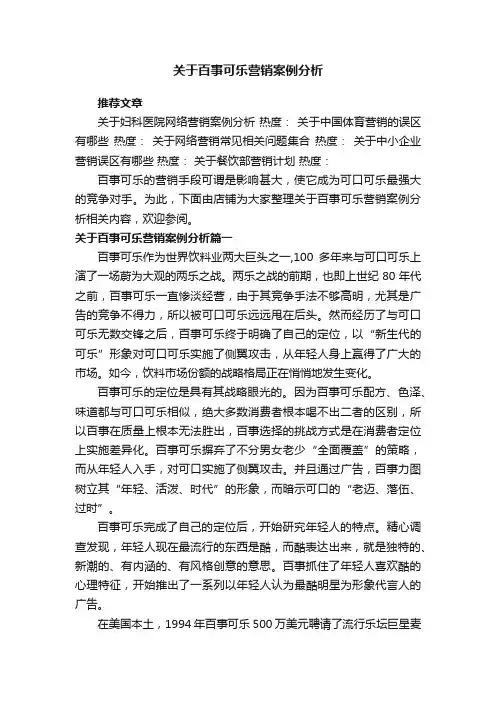
关于百事可乐营销案例分析推荐文章关于妇科医院网络营销案例分析热度:关于中国体育营销的误区有哪些热度:关于网络营销常见相关问题集合热度:关于中小企业营销误区有哪些热度:关于餐饮部营销计划热度:百事可乐的营销手段可谓是影响甚大,使它成为可口可乐最强大的竞争对手。
为此,下面由店铺为大家整理关于百事可乐营销案例分析相关内容,欢迎参阅。
关于百事可乐营销案例分析篇一百事可乐作为世界饮料业两大巨头之一,100多年来与可口可乐上演了一场蔚为大观的两乐之战。
两乐之战的前期,也即上世纪80年代之前,百事可乐一直惨淡经营,由于其竞争手法不够高明,尤其是广告的竞争不得力,所以被可口可乐远远甩在后头。
然而经历了与可口可乐无数交锋之后,百事可乐终于明确了自己的定位,以“新生代的可乐”形象对可口可乐实施了侧翼攻击,从年轻人身上赢得了广大的市场。
如今,饮料市场份额的战略格局正在悄悄地发生变化。
百事可乐的定位是具有其战略眼光的。
因为百事可乐配方、色泽、味道都与可口可乐相似,绝大多数消费者根本喝不出二者的区别,所以百事在质量上根本无法胜出,百事选择的挑战方式是在消费者定位上实施差异化。
百事可乐摒弃了不分男女老少“全面覆盖”的策略,而从年轻人入手,对可口实施了侧翼攻击。
并且通过广告,百事力图树立其“年轻、活泼、时代”的形象,而暗示可口的“老迈、落伍、过时”。
百事可乐完成了自己的定位后,开始研究年轻人的特点。
精心调查发现,年轻人现在最流行的东西是酷,而酷表达出来,就是独特的、新潮的、有内涵的、有风格创意的意思。
百事抓住了年轻人喜欢酷的心理特征,开始推出了一系列以年轻人认为最酷明星为形象代言人的广告。
在美国本土,1994年百事可乐500万美元聘请了流行乐坛巨星麦克尔?杰克逊做广告。
此举被誉为有史以来最大手笔的广告运动。
杰克逊果然不辱使命。
当他踏着如梦似狂的舞步,唱着百事广告主题曲出现在屏幕上时,年轻消费者的心无不为之震撼。
在中国大陆,继邀请张国荣和刘德华做其代言人之后,百事可乐又力邀郭富城、王菲、珍妮?杰克逊和瑞奇?马丁四大歌星做它的形象代表。
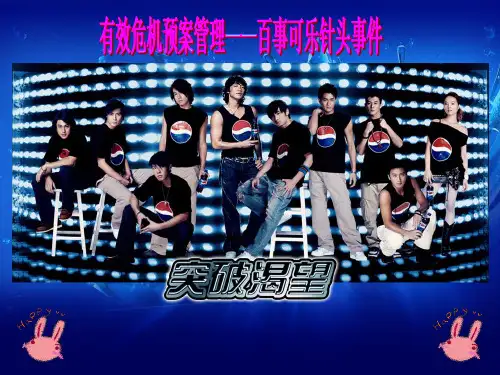

百事可乐案例分析引言百事可乐是世界上最著名的碳酸饮料之一,其在全球范围内享有广泛的知名度和消费者基础。
本文将通过对百事可乐公司的案例分析,探讨其成功的关键因素以及面临的挑战。
一、百事可乐公司的发展历程百事可乐公司成立于19世纪80年代,最初是一个小规模的饮料生产厂商。
随着时间的推移,该公司逐渐扩大了生产规模,并推出了一系列新产品,其中包括著名的百事可乐。
通过不断的创新和市场拓展,百事可乐公司成功地打造了一种独特的品牌形象,成为全球饮料行业的领导者之一。
二、百事可乐的市场地位百事可乐在全球范围内享有广泛的市场份额和消费者忠诚度。
根据最新的市场调研数据显示,百事可乐是全球最受消费者欢迎的碳酸饮料品牌之一。
其产品线包括经典可乐、无糖可乐、橙味汽水等多种口味选择,以满足不同消费者的需求。
此外,百事可乐公司还通过市场推广活动、明星代言人以及赞助活动等方式来增强品牌形象和市场影响力。
三、百事可乐的营销策略百事可乐采用了多种营销策略来推动产品销售并树立品牌形象。
首先,百事可乐积极寻求与全球各地的超市和便利店建立合作关系,以确保产品的广泛可得性。
此外,该公司还举办了大规模的促销活动,如买一送一、满减等,以吸引消费者购买。
此外,百事可乐还与知名体育赛事和明星合作,通过赞助活动和广告宣传,增强了品牌形象。
四、百事可乐面临的挑战虽然百事可乐在全球范围内取得了巨大的成功,但该公司仍然面临一些挑战。
首先,随着健康意识的提高,消费者对含糖饮料的需求下降,这对百事可乐的销售产生了一定影响。
此外,全球饮料市场竞争激烈,百事可乐不仅面临来自可口可乐等主要竞争对手的竞争压力,还面临着新兴品牌的崛起。
五、百事可乐的未来发展方向为了应对市场的挑战,百事可乐公司采取了一系列措施来提升自身的竞争力。
首先,百事可乐致力于开发更多的无糖和低糖产品,以迎合健康意识日益增强的消费者需求。
其次,百事可乐加大了对新市场的开拓力度,特别是在发展中国家市场中的投资。

百事可乐广告案例分析百事可乐广告案例分析“新一代的选择”是百事可乐的广告语,从这则广告语中我们就能体会到它的市场定位。
“定位的基本方法,不是去创作某种新奇或与众不同的事项,而是去操作已经存在于心中的东西,去重新结合已存在的联结关系。
”定位的基点并不是产品,而是着重于产品与消费者心理位置的统一。
定位的目的是为了在消费者心目中确立本产品与众不同的优势。
定位所宣称的并非同类产品所没有的,而应该是竞争对手没有说明的,或者是尚未引起注意的,但却确确实实对消费者具有吸引力的那部分特征。
因此,定位是从消费者的心理需求空间出发,对产品优势的一种创造,既创造功能更创造形象。
百事可乐从4P和消费群体的心理特征的角度把市场定位于年轻人。
百事公司作了一次市场调查。
调查人员发现:当消费者在挑选软饮料时,他们实际上做出了三项选择,第一他们拿定主意喝软饮料,而不是果汁、水或者牛奶;接着他们选择了可乐,而不是雪碧,七喜或者其他软饮料。
只有在这时,他们才开始从百事可乐和可口可乐及其它可乐中挑选。
同时,调查结果还表明,消费者认为百事可乐公司是一家年轻的企业,具备新的思想,富有朝气和创新精神,是一个发展很快、赶超第一的企业,不足之处是鲁莽,甚至有点盛气凌人。
而可口可乐得到的积极评价是:美国的化身,可口可乐是“真正的”正牌可乐,具备明显的保守传统;不足之处是老成迟钝、自命不凡,还有点社团组织的味道。
所以百事可乐选择青少年作为自己的形象,年轻人充满情趣,令人振奋,富有创新精神。
例如:1994年,百事可乐又投入500万美元聘请了流行乐坛巨星麦克尔·杰克逊拍摄广告片。
此举被誉为有史以来最大手笔的广告运动。
而且调查表明,这也是有史以来最成功的广告片,这部广告片开播不到30天,百事可乐的销售量就开始上升。
在中国大陆,继邀请张国荣和刘德华做其代言人之后,百事可乐又力邀郭富城、王菲、珍妮·杰克逊和瑞奇·马丁四大歌星做它的形象代表。
百事可乐经典营销成功案例分析独特的音乐推销1998年,百事可乐百年之际,百事推出了一系列的营销举措。
1998年1月,郭富城成为百事国际巨星,他与百事合作的第一部广告片,是音乐"唱这歌"的MTV情节的一部分。
身著蓝色礼服的郭富城以其活力无边的外型和矫健的舞姿,把百事一贯的主题发挥得淋漓尽致。
此片在亚洲地区推出后,引起了年轻一代的普遍欢迎。
1998年9月,百事可乐在全球范围推出其最新的蓝色包装。
配合新包装的亮相,郭富城拍摄了广告片"一变倾城",音乐"一变倾城"也是郭富城新专辑的同名主打歌曲。
换了蓝色"新酷装"的百事可乐,借助郭富城"一变倾城"的广告和大量的宣传活动,以"askformore"为主题,随著珍妮。
杰克逊、瑞奇。
马订王菲和郭富城的联袂出击,掀起了"渴望无限"的蓝色风暴。
由郭富城和珍妮。
杰克逊联袂演出的主题广告片"渴望无限"投资巨大,场面恢弘,是百事近年力推的作品。
歌曲"渴望无限"由珍妮。
杰克逊作曲,音乐从慢节奏过渡到蓝色节奏,最后变成20世纪60年代的House音乐,曲风华丽。
郭富城美伦美奂的表演和性感的造型,珍妮。
杰克逊大气的唱功,使整个广告片充满了浪漫色彩,尤其由来自不同地区、不同肤色的两位巨星共同演绎,更加引人注目。
王菲的歌曲在亚洲乐坛独树一帜,她为百事拍的广告片同样以"渴望无限"为主题,由她创作的音乐《存在》表现了王菲对音乐的执著追求和坚定信念。
"渴望无限"的理念得到了很好的诠释和体现。
2002年1月,乐坛天之娇女--郑秀文小姐正式加盟百事家族,成为新一代中国区百事巨星。
2002年,F4的"百事可乐"广告成为备受中国消费者欢迎的广告。
音乐的传播与流行得益于听众的传唱,百事的音乐营销成功正在于它感悟到了音乐的沟通魅力,这是一种互动式的沟通。
百事可乐管理学案例篇一:案例分析^p 之百事可乐挑战可口可乐案例分析^p 之“百事可乐挑战可口可乐”一、分析^p 百事可乐挑战可口可乐的竞争战略与策略:(一)根据迈克尔.波特归纳的竞争战略基本模式,我认为百事可乐在竞争中运用了集中一点战略(即:将经营范围集中于行业内某一细分市场),具体表现为:20世纪60年代,百事敏锐的发现二战后出生的新一代成为了社会的主要消费对象,便及时地把营销战略的重点放在朝气蓬勃的年轻一代的身上。
(二)从进攻策略的角度来看,我认为百事可乐主要运用了以下三种进攻策略:(1)正面进攻(即:集中全力向对手的主要市场阵地发动进攻,也就是进攻对手的强项而不是弱项。
),具体表现为:可口可乐从188年诞生至20世纪20年代,根本没有对手,成为了“世界饮料之王”,并享有“饮料日不落帝国”的美誉。
但百事可乐却在可口可乐全球市场的各个角落,与可口可乐展开了激烈的斗争。
(2)侧翼进攻(即:集中优势力量攻击对手的弱点。
),具体表现为:百事可乐利用可口可乐和包装商们的矛盾,争取了数家包装商的支持,是可口可乐遭受了一次非常公开的挫折。
(3)迂回进攻(即:完全避开对手现有阵地而迂回进攻:①发展无关产品,实行产品多角化;②以现有产品进入新地区的市场,是想市场多角化。
),具体表现为:①自20世纪60年代起,百事可乐就是图打破单一的业务种类,迅速发展其他行业,使公司成为多角化企业。
而可口可乐在70年代才开始其多角化的发展。
②可口可乐虽然借第二次世界大战之机开辟了牢固的海外市场,但尚有不少空白之地,百事可乐的战略就是进入可口可乐未进入或进入失败的“真空地带”。
(三)另外,面对强大的对手,百事可乐总是在恰当的时机运用如下竞争策略:(1)价格竞争策略(即:通过降低产品价格而谋求扩大销量,提高产品市场占有率的竞争。
),具体表现为:1929年,美国进入了经济大萧条时期,此时,消费者对价格很敏感,而百事可乐瞄准时机向公众表示,同样5分钱,原来只可买到6.5盎司一瓶的可口可乐,现在却可以买到12盎司一瓶的百事可乐。
第1篇一、案例背景可口可乐和百事可乐作为全球两大饮料巨头,在我国市场上竞争激烈。
两家公司不仅产品竞争激烈,商标纠纷也层出不穷。
本文将介绍一起百事经典法律案例——可口可乐与百事可乐的商标侵权纠纷。
二、案情简介2007年,我国某知名饮料公司(以下简称“原告”)在市场上发现,一款名为“百事可乐”的饮料产品,其外包装、瓶身设计、颜色等与原告公司注册的“百事可乐”商标高度相似。
原告认为,该饮料公司未经其许可,擅自使用与其注册商标相同的文字、图形,构成商标侵权。
于是,原告将涉案饮料公司及生产商、经销商诉至法院,要求判令被告停止侵权行为,赔偿经济损失。
三、争议焦点1. 涉案饮料公司是否构成商标侵权?2. 如构成侵权,原告要求赔偿经济损失的数额是否合理?四、法院判决1. 关于商标侵权问题,法院认为,涉案饮料公司未经原告许可,在其产品上使用与原告注册商标相同的文字、图形,足以使消费者产生混淆,侵害了原告的商标专用权。
因此,涉案饮料公司构成商标侵权。
2. 关于赔偿经济损失的数额,法院认为,涉案饮料公司侵权行为持续时间较长,侵权产品数量较大,且侵权产品与原告注册商标高度相似,容易误导消费者。
综合考虑涉案饮料公司的侵权情节、原告的损失等因素,法院判决涉案饮料公司赔偿原告经济损失及合理费用共计人民币50万元。
五、案例分析1. 涉案饮料公司构成商标侵权。
根据《中华人民共和国商标法》第五十七条的规定,未经注册商标所有人的许可,在同一种商品或者类似商品上使用与其注册商标相同或者近似的商标,容易导致混淆的,构成商标侵权。
本案中,涉案饮料公司在其产品上使用与原告注册商标相同的文字、图形,足以使消费者产生混淆,侵害了原告的商标专用权。
2. 原告要求赔偿经济损失的数额合理。
根据《中华人民共和国商标法》第五十六条的规定,商标侵权人应当赔偿被侵权人的损失。
本案中,法院综合考虑涉案饮料公司的侵权情节、原告的损失等因素,判决涉案饮料公司赔偿原告经济损失及合理费用共计人民币50万元,符合法律规定。
BUSINESS CASE STUDY: PepsiCoCompany OverviewSector: Manufacturing (food and beverage) Number of Employees: 274,000 Headquarters: Purchase, NY Revenues: $66.415 billionInitiative Overview #1: Food for GoodDepartment: Food for Good (FFG) is a social enterprise program within PepsiCo Time Frame: 2009-presentFunding: Program revenues cover the costs of the meals and operations, which run at break-even. PepsiCo’s R&D team funds innovation of new products and technologies. Geography: Dallas/Fort Worth (TX), Austin (TX), Houston (TX), Waco (TX), Little Rock (AK), Detroit (MI), Oklahoma City (OK), Denver (CO)BackgroundFood for Good (FFG) creates scalable, break-even, business-driven solutions that make nutrition and employment more accessible for low-income families, and incubates low-cost innovation to accelerate PepsiCo’s commitment to “Performance with Purpose.”Executive LeadershipCEO Indra Nooyi advocates strongly on behalf of FFG both externally and internally, and Mehmood Khan, Vice Chairman and Chief Scientific Of ficer, is FFG’s executive sponsor.GoalsDevelop and deliver pre-packed meals to children that meet U.S. Department of Agriculture (USDA) standards, and support non-profit partners running retail farm stands stocked with affordably priced produce in underserved communities. Long term, Food for Good supports PepsiCo’s new product development.Shared Value for PepsiCo and CommunitiesFFG delivers meals to children 18 and younger as well as to persons with disabilities over 18 in qualifying low-income areas through the USDA Summer Food Service Program. FFG generates revenue by selling food, which is then re-invested into the program. Employees from PepsiCo’s research and development (R&D) team engage with the program to improve food delivery logistics and develop cooling technology for food delivery, and FFG program staff build partnerships with non-profits and local governments. PepsiCo benefits from new relationships with non-profit partners and opportunities to develop new products and technologies, while also expanding access to healthy food in underserved communities.Community Choice is Driven By:∙Partnerships: PepsiCo chooses FFG communities based on the invitation of local non-profit partners and local governments looking to engage the company on cross-sector collaboration.∙Community Need: FFG prioritizes cities in which to implement the program based on the magnitude of need, or by relative unmet need.∙Customer Retention & Attraction: In addition to fresh fruits and vegetables, the meals PepsiCo delivers include PepsiCo products that are USDA approved for the summer food service program. FFG thereby enables PepsiCo to reach a broader consumer base.∙Community Risk/Disease Burden Assessment: See below.Assessing Community Risk & Disease Burden∙The company used USDA data to identify the number of Americans that live in food deserts (29M), Children that receive free and reduced lunch (22M), and Children that do not access healthy meals during the summer (19M).∙Community consultations revealed that largely due to logistical challenges, children on free or reduced lunch programs were not getting appropriate nutrition during summer months. The transportation and physical access barrier to delivering meals during summer months has also been documented by the USDA and No Kid Hungry.Program Reach∙Employees: Employees from the R&D team engage with the program to improve food delivery logistics, develop cooling technology, and build partnerships with non-profits and local governments. PepsiCo employees volunteer every year with FFG, helping with things such as playing games with the kids at summer feeding sites to serving on the program’s Steering Committee.∙Communities: FFG is present in 8 cities (Denver, Dallas, Oklahoma City, Austin, Houston, Waco, Little Rock, and Detroit). Children 18 and younger in qualifying low-income areas may receive free meals and snacks through the Summer Food Service Program. Meals and snacks are also available to persons with disabilities, over age 18, who participate in school programs for people who are mentally or physically disabled.Data CollectionProgram Results & ImpactCommunity Results∙Local Support: FFG supports 10 local non-profit organizations with in-kind food contributions that promote nutrition education and health lifestyles. Examples include the donation of a Frito-Lay route van to be converted into a mobile nutrition education classroom and a PepsiCo Foundation gift to United Way (one of 7 organizations that received PepsiCo Foundation support) to create a nutrition/activities “toolkit” for summer meal programs.∙Job Creation: More than 100 jobs were created to manage warehouses, drive delivery trucks, package food, and supervise field staff; hiring was from the same communities FFG serves. Local non-profit partners create another 100+ summer jobs each year to provide physical activities and nutrition education for the children. Many FFG summer employees later received full-time positions within PepsiCo. With year-round after school programs in Dallas/Fort Worth, Austin and Little Rock, FFG employs a full-time field staff of 20+ people.∙Urban Farming: FFG partnered with Paul Quinn College, a Historically Black College/University (HBCU), in southern Dallas to convert their football field into an organically maintained urban farm. The farm produces fresh fruits and vegetables and has become a part of the College’s curriculum as a social entrepreneurship course led by the FFG team and executives from PepsiCo/Frito-Lay.∙Community and Pop-Up Markets: A pilot with five fresh community markets and pop-up farm stands began in 2010; they have sold over 400,000 servings of produce.∙Weekend Backpack Meal Bundles: FFG packaged and delivered bundles of nutritious meals for children to take home over the weekend. This pilot that began in Austin expanded to Fort Worth and Little Rock. FFG projects to deliver 1 million “backpack” servings in 2015.∙Meals Served: FFG delivered 16 servings to low-income children since 2009. In 2014, FFG delivered 1.4M meals, with 6.1M servings of grains, dairy, fruits, and vegetables in the following communities:Meals and Children Served by Food for Good in 2014City Number ofMeals ServedNumber ofChildren ServedLocationsDallas/Fort Worth 700,000 15,000 173Austin 450,000 6,000 152Houston 90,000 2,000 35Waco 15,000 400 11Little Rock 115,000 2,000 72Detroit 40,000 1,200 31Oklahoma City 10,000 300 12Denver 15,000 400 21Business Impact∙Government relations: FFG engaged local leaders from the non-profit and government sectors and opened up channels of communication and opportunities for cross-sector collaboration that were previously unavailable.∙Innovation: FFG serves as a learning laboratory for new technologies and business models, such as a low-cost, long-lasting cooling technology that opens new distribution options for FFG and PepsiCo.∙Market Research: PepsiCo served meals across 8 markets. The company shares insights from serving these communities to find opportunities to deliver products to new consumer bases.∙Product Development: PepsiCo developed and launched the Quaker Maple Brown Sugar Chewy Bar specifically for school breakfasts.∙Talent Acquisition: Over 100 front-line employees are hired each summer and after the term, some are offered full time positions within Frito-Lay. Some of the FFG “alumni” have gone on to win awards like Route Sales Representative of the year with Frito-Lay.################Initiative Overview #2: Healthy Weight Commitment FoundationDepartment:PepsiCo's Chairman and CEO Indra K. Nooyi is currently the chair of the HWCFTime Frame:2009-presentFunding: Since 2009, PepsiCo and the PepsiCo Foundation contributed $4.5 million to HWCFGeography: NationalBackgroundThe Healthy Weight Commitment Foundation (HWFC) a is coalition that brings together more than 275 retailers, food and beverage manufacturers, restaurants, sporting goods and insurance companies, trade associations, nongovernmental organizations (NGOs), and professional sports organizations. One of its main initiatives is a calorie reduction pledge made by 16 HWCF food and beverage companies to the First Lady’s Let’s Move! initiative. PepsiCo was one of the 16 founding companies, and its participation aligns with its company strategy, “Performance with a Purpose.“Vision & Goals∙Reducing calories in the marketplace by 1 trillion by 2012 and 1.5 trillion by 2015∙Growing and introducing lower calorie options in product portfolio of businesses that make the pledge by changing product recipes where possible, reducing portion sizes of existing single serve products to reduce calorie intake and introducing new lower-calorie optionsShared Value: Cutting Calories Boosts Business GrowthBusinesses changed product recipes where possible, introduced portion controlled or single serve products, and introduced new lower calorie products. Many companies used all three mechanisms to make their changes. An evaluation of HWCF companies found that lower calorie foods and beverages drove companies’ sales growth.Engaging Stakeholders∙Pledges: HWCF brought together more than 275 retailers, food and beverage manufacturers, restaurants, sporting goods and insurance companies, trade associations, NGOs, and professional sports organizations to make a significant commitment in the marketplace and promote active healthy living.∙Corporate Membership: 35 corporations provide funding and support for programs and activities and help set the direction of the HWCF.∙Associate Membership: Over 250 associate members support the concept of energy balance in their marketing campaigns and communications.Program ReachBusinesses: The coalition includes 275 retailers, food and beverage manufacturers, restaurants, sporting goods and insurance companies, trade associations, NGOs, and professional sports organizations.Evaluation and ImpactCalorie Reduction and Product Reformulations on Business Sales & Product AvailabilityFunded by the HWCF, the Hudson Institute analyzed sales data from the 16 major food and beverage companies among the Foundation’s members to determine both trends in sales and product availability over 5 years.Community ImpactCalorie ReductionAn evaluation published in the American Journal of Preventative Medicine and funded by the Robert Wood Johnson Foundation found that the HWCF companies removed 6.4 trillion calories from the marketplace from 2007-2012, exceeding their goal by 400 percent. This represents a 78 calorie reduction per person —three years ahead of schedule. Availability of Healthier Options in Stores∙Over the course of 5 years, the number of new lower-calorie products on shelves grew 14.1 percent, twice the rate of growth of higher-calorie products.∙While slightly fewer lower-calorie products were introduced compared to higher-calorie versions, the number of lower-calorie products that remained on the market after 5 years was double that of higher-calorie items indicating a higher ‘stick’ rate for lower cal orie items.∙Increase in lower-calorie retail availability mirrored sharp sales gains: lower calorie growth in total points of All Commodity Volume (ACV) distribution increased by 2.9%, whereas distribution of higher calorie products remained flat (+ .1%)Business Impact: Sales∙99% of sales growth came from low- or no- calorie products; these products, accounted for 52.5% of sales.∙Lower-calorie product sales were up significantly by $485 million while higher-calorie items remained flat, increasing by only $2 million.∙Companies that grew their lower-calorie products increased total sales by $1.8 billion, while companies with flat or declining sales of lower-calorie items suffered declines in total sales of $1.3 billion.∙In-store promoted sales of lower-calorie products grew +9.0%, more than 1.5 times the rate of higher-calorie products.This case study was adopted from a semi-structured qualitative interview and publicly available information. To learn more about the link between workforce and community health and the strategies businesses are implementing to invest in community health, read the Vitality Institute’s report “Beyond the Four Walls: Why Community is Critical to Workforce Health”.To access the report and additional case studies, visit /communityhealth or look us up on social media @VitalityInst #Beyond4Walls.。